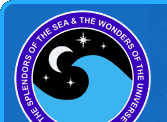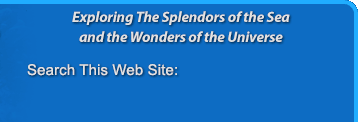1800


1807
U.S. Coast Survey Established
President Thomas Jefferson signs a law establishing the United States Coast Survey. The organization studies the eastern coast of the United States and returns data about a wide range of maritime subjects including tides and tidal currents, sea floor characteristics, and the depth and physical features of near-shore waters.
1820

1825
First use of Scuba
Englishman William H. James designs a self-contained underwater breathing apparatus, or scuba. In James' design, the diver wears a helmet and carries a supply of compressed air in a cast-iron belt fastened around the waist. This device allows the diver to remain underwater for up to an hour.
1830


Wikipedia Public Domain Image
December 27, 1831
Voyage of the H.M.S. Beagle
English naturalist Charles Darwin departs England aboard the H.M.S. Beagle. The goal of the expedition is to perform a survey of Patagonia and Tierra del Fuego. Darwin studies the plants and animals at each new stop. He discovers many unique species on the Galapagos Islands off the coast of Peru in South America. These discoveries lead to his groundbreaking theory of evolution. In his book, The Origin of Species, Darwin suggests that the deep ocean may be a sanctuary for living fossils.


Wikipedia Public Domain Image
1837
First Practical Diving Suit
Augustus Siebe, a German instrument maker, refines and improves previous diving suit designs and introduces the "Siebe Improved Diving Dress". This diving suit is the true predecessor to the famous deep-sea diving suit familiar to everybody today. The improved design allows a greater freedom of movement for the diver and would be used for over a century.
1840


Wikipedia Public Domain Image
January 3, 1840
First Modern Sounding
British Royal Navy officer and polar explorer Sir James Clark Ross conducts the first open ocean deep-water sounding in 2,425 fathoms (14,450 feet or 4404 meters) in the south Atlantic ocean at at Latitude 27 S Longitude 17 W. The sounding is taken using the traditional method of lowering a hemp rope over the side of the ship.


Wikipedia Public Domain Image
1842
Darwin on Coral Reef Atolls
British naturalist Charles Darwin publishes The Structure and Distribution of Coral Reefs. In this work he discusses how coral atolls are formed from the subsidence and erosion of volcanic islands. Darwin's theory that reefs formed as the islands and surrounding areas subsided has been supported by modern investigations, and is no longer disputed.


Wikipedia Public Domain Image
1843
Speculation on Deep Sea Life
British naturalist Edward Forbes states his belief that life cannot exist below 300 fathoms (1,800 feet or 548 meters) in the deep sea. This declaration begins a 20-year debate about the possible existence of a lifeless zone in the ocean known as an azoic zone. This idea is known as Azoic hypothesis and the Abyssus theory and has long since been disproven.

1849
Continental Shelf
Coast Survey soundings in support of Gulf Stream investigations result in the discovery of the continental shelf break and the continental slope.
1850

1853
Discovery of Deep Sea Life
Edward Forbes' theory of on deep sea life is called into question when Louis F. de Pourtales of the U.S. Coast Survey examines Coast Survey sounding operations that find indications of life in depths over 1,000 fathoms (6,000 feet or 1,830 meters).


Wikipedia Public Domain Image
1857
First Deep Sea Canyon Discovered
James Alden, commanding officer of the Coast Survey Steamer Active, discovers a deep submarine valley, or "gulch," in the center of Monterey Bay off the coast of California. Alden had discovered the first known deep sea canyon, now known as Monterey Canyon. This canyon extends 95 miles (153 kilometers) into the Pacific Ocean and reaches a depth of 11,800 feet (3,596 meters).
1860


Public Domain Image
1860
First Chart of the Gulf Stream
The first chart of the Gulf Stream is published by the U.S. Coast Survey. The Gulf Stream is a warm ocean current that originates in the Gulf of Mexico and travels up the eastern coast of the North America, where it brings warmer climate to the northern regions of the Atlantic Ocean. The current can have a significant impact on ships traveling in the area.


Wikipedia Public Domain Image
1861
First U.S. Navy Submarine
The United States Navy contracts French emigrant Brutus de Villeroi to design a submarine. The vessel is built by the firm of Neafie & Levy and is made of iron with small circular plates of glass on top for light. Known as the Alligator, the sub is powered by sixteen hand-powered paddles protruding from the sides. It was built for use in the Civil War, but was never used in battle.


Wikipedia Public Domain Image
1867
Proof of Deep Sea Life
American naturalist Louis F. de Pourtales conducts dredging operations from the Coast Survey Steamers Corwin and Bibb off the southern coast of Florida. During the operation, he finds prolific life extending below 300 fathoms (1,800 feet or 550 meters).


Wikipedia Public Domain Image
1868
Deep Sea Life in Abundance
Scottish naturalist Charles Wyville Thomson dredges the ocean floor from the HMS Lightning and Porcupine and discovers life as deep as 2,400 fathoms (14,400 feet or 4,389 meters). This evidence finally disproves Edward Forbes' theory of a lifeless (azoic) zone below 300 fathoms (1,800 feet or 548 meters). Thomson later serves as chief scientist on the Challenger expedition, where his work revolutionizes oceanography.
1870


Wikipedia Public Domain Image
1872
Early Marine Survey of the Americas
Swiss naturalist Louis Agassiz takes the steamship Hassler on a biological survey of the Americas. The expedition begins on the East Coast of the United States and continues south through the Straits of Megellan and on to San Francisco. The ship is outfitted for deep ocean sounding and dredging. More than 30,000 specimens of marine life are collected and cataloged.


Wikipedia Public Domain Image
1872
First Wireline Sounding
Irish physicist and engineer Sir William Thomson invents an operational wireline sounding machine. Modifications of this machine ultimately replace the traditional hemp-rope sounding methods. The new wireline machines are faster and more accurate, making it much easier for researchers to survey the ocean depths.


NOAA Public Domain Image
December 21, 1872
Voyage of the H.M.S. Challenger
Intrigued by the earlier work by Charles Darwin aboard the Beagle, the H.M.S. Challenger sails from Portsmouth, England and begins a four-year around the world. During the voyage, scientists test the salinity, temperature and density of the seawater. Information is also collected about ocean currents, sediment, and meteorology. The crew discovers underwater mountain chains and hundreds of species of marine life previously unknown. This research is eventually consolidated into a fifty-volume report known as The Challenger Report. This research forms the basis of modern oceanography.


Image © Scripps Institution
of Oceanography
1874
Sigsbee Sounding Machine
Commander Charles D. Sigsbee commands the Coast Survey Steamer Blake, where he modifies the Thomson Sounding Machine. The machine uses wire rope to take ocean depth soundings. Sigsbee's improved instrument is termed the Sigsbee Sounding Machine. It becomes the basic model for wireline sounding in the deep sea for the next 50 years.
1880


NOAA Public Domain Image
1882
First Oceanographic Research Vessel
The U.S. Fisheries Commission Steamer Albatross begins operations. The Albatross is the first vessel built by any government for the sole purpose of oceanographic research. This iron-hulled, twin-screw steamer conducts serious marine research for nearly 40 years until it is finally decommissioned in 1921.


Myrabella / CC BY-SA 3.0
1882
First Anthropomorphic
Atmospheric Diving Suit
The Carmagnolle brothers of Marseilles, France design and build the first antropomorphic atmospheric diving suit. It features rolling convolute joints consisting of partial sections of concentric spheres formed to create a close fit. The suit has 22 of these joints. There are four in each leg, six per arm, and two in the body of the suit. It is kept watertight with a waterproof cloth.


NOAA Public Domain Image
1885
First Deep Anchoring Techniques
The Coast and Geodetic Survey Steamer Blake, under Commander John Elliott Pillsbury, pioneers deep-ocean anchoring techniques during Gulf Stream studies. The Blake is reported to have anchored in 2,200 fathoms (13,200 feet or 4,023 meters).


NOAA Public Domain Image
1888
First Modern Electric Submarine
The French Navy launches the submersible Gymnote. It is the first electrically powered and fully functional military submarine. The steel-hulled craft is powered by a 204-cell battery. It completes over 2,000 successful dives before being scrapped for its limited range.
1890


NOAA Public Domain Image
1899
Marine Survey of the Pacific
Swiss Zoologist Alexander Agassiz makes several expeditions on the steamship Albatross to study coral reefs in the Pacific Ocean. The ship's crew makes soundings and collects specimens from islands and atolls in the South Pacific. Over the next six years, the expeditions discover an abundant range of marine life from previously unexplored remote regions.




